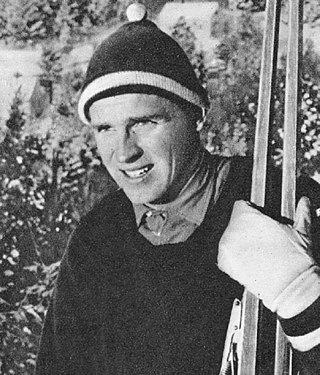
The biathlon is a winter sport that combines cross-country skiing and rifle shooting. It is treated as a race, with contestants skiing through a cross-country trail whose distance is divided into shooting rounds. The shooting rounds are not timed per se, but depending on the competition, missed shots result in extra distance or time being added to the contestant's total.

The 1960 Winter Olympics were a winter multi-sport event held from February 18 to 28, 1960, at the Squaw Valley Resort in Squaw Valley, California, United States. The resort was chosen to host the Games at the 1956 meeting of the International Olympic Committee (IOC). Squaw Valley was an undeveloped resort in 1955, so the infrastructure and all of the venues were built between 1956 and 1960 at a cost of US$80,000,000. The layout was designed to be intimate, allowing spectators and competitors to reach most of the venues on foot.

The 1964 Winter Olympics, officially known as the IX Olympic Winter Games and commonly known as Innsbruck 1964, was a winter multi-sport event which was celebrated in Innsbruck, Austria, from January 29 to February 9, 1964. The city was already an Olympic candidate, unsuccessfully bidding to host the 1960 Games. Innsbruck won the 1964 Games bid, defeating the cities of Calgary in Canada and Lahti in Finland. The sports venues, many of which were built for the Games, were located within a radius of 20 km (12 mi) around Innsbruck. The Games included 1,091 athletes from 36 nations, which was a record for the Winter Games at the time. Athletes participated in six sports and ten disciplines which bring together a total of thirty-four official events, seven more than the 1960 Winter Olympic Games. The luge made its debut on the Olympic program. Three Asian nations made their Winter Games debut: North Korea, India and Mongolia.
Biathlon at the 1960 Winter Olympics consisted of one biathlon event, held at McKinney Creek Stadium, Tahoma, California. The event occurred on 21 February 1960. This was the first appearance of modern biathlon in the Olympic Games. In 1924, a military patrol event was held. Some sources do not include this military patrol race as an Olympic event, but the IOC considers it an event within biathlon.

The Men's 20 kilometre individual biathlon competition at the 2006 Winter Olympics in Turin, Italy was held on 11 February, at Cesana San Sicario.

Biathlon debuted at the 1960 Winter Olympics in Squaw Valley, California with the men's 20 km individual event. At the 1968 Winter Olympics in Grenoble, the men's 4 × 7.5 km relay debuted, followed by the 10 km sprint event at the 1980 Winter Olympics in Lake Placid, New York. Beginning at the 1992 Winter Olympics in Albertville, women's biathlon debuted with the 15 km individual, 3 × 7.5 km relay, and 7.5 km sprint. A pursuit race was included at the 2002 Winter Olympics in Salt Lake City. The top 60 finishers of the sprint race would qualify for the pursuit event. The sprint winner starts the race, followed by each successive biathlete at the same time interval they trailed the sprint winner in that event. At the 2006 Winter Olympics in Turin, a mass start was introduced where the top 30 biathletes from the previous four events were allowed to start together for the competition.

Vladimir Mikhailovich Melanin was a Soviet biathlete.

Klas Ivar Vilhelm Lestander was a Swedish biathlete who won a gold medal at the 1960 Winter Olympics in Squaw Valley.
McKinney Creek Stadium was a temporary ski stadium located at Tahoma, California, in the United States. Built in 1959, it was used for cross-country skiing, Nordic combined, and biathlon at the 1960 Winter Olympics in Squaw Valley.
For the 1960 Winter Olympics in Squaw Valley, California, in the United States, a total of five sports venues were used. Except for the Palisades Tahoe, all of the venues had to be constructed. For the first time in Winter Olympic history, a temporary venue was constructed at McKinney Creek for biathlon, cross-country skiing, and Nordic combined. A bobsleigh track was not constructed over the guarantees from the FIBT not being able to field the minimum twelve teams needed to compete, making it the only time bobsleigh has not been included in the Winter Olympics.
The Men's 4 x 7.5 kilometre biathlon relay competition at the 1984 Winter Olympics 17 February, at Igman - Veliko Polke. Each national team consisted of four members, with each skiing 7.5 kilometres and shooting twice, once prone and once standing.
The Men's 10 kilometre sprint biathlon competition at the 1984 Winter Olympics was held on 14 February, at Igman - Veliko Polke. Competitors raced over three loops of the skiing course, shooting two times, once prone and once standing. Each miss was penalized by requiring the competitor to race over a 150-metre penalty loop.
The Men's 20 kilometre individual biathlon competition at the 1984 Winter Olympics was held on 11 February, at Igman - Veliko Polke. Each miss resulted in one minute being added to a competitor's skiing time.
The Men's 20 kilometre individual biathlon competition at the 1980 Winter Olympics was held on 16 February, at Lake Placid Olympic Sports Complex Cross Country Biathlon Center. Each miss of the target cost two minutes, while hitting the outer circle cost one minute.
The men's 20 kilometre individual biathlon competition at the 1968 Winter Olympics was held on 12 February, at Autrans. Each miss of the target cost two minutes, while hitting the outer circle cost one minute.
The Men's 20 kilometre individual biathlon competition at the 1964 Winter Olympics was held on 4 February, at Seefeld. The firing ranges were located at the following points on the 20-kilometer course: 6 km — 200 meter range, 10.4 km — 250 meter range, 11.8 km — 150 meter range and 17.1 km — 100 meter range. The first three series were fired from a prone position, the last standing. Each miss of the target cost two minutes.
The 15 kilometre cross-country skiing event was part of the cross-country skiing programme at the 1960 Winter Olympics, in Squaw Valley, California, United States. It was the second appearance of the event at its length of 15 km. The competition was held on Tuesday, February 23, 1960, at the McKinney Creek Stadium.
The 50 kilometre cross-country skiing event was part of the cross-country skiing programme at the 1960 Winter Olympics, in Squaw Valley, California, United States. It was the fifth appearance of the event at its length of 30 km. The competition was held on Saturday, February 27, 1960 at the McKinney Creek Stadium.
The mixed relay competition of the 2022 Winter Olympics was held on 5 February, at the National Biathlon Centre, in the Zhangjiakou cluster of competition venues, 180 kilometres (110 mi) north of Beijing, at an elevation of 1,665 metres (5,463 ft). The event was won by Norway. France was second, and the Russian Olympic Committee third.







